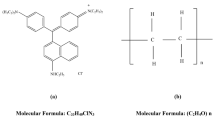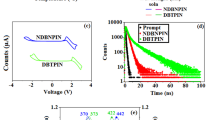Abstract
In this study, we aim to explore the chemical and physical properties of Brilliant Green Dye (BGD) that make it a functional material in interesting optical devices such as nonlinear optical and photovoltaic applications. For that, experimental spectroscopies, Fourier-transform infrared (FT-IR) and Raman are used to conduct and discuss the modes of vibration of the groups existing in BGD, this experimental study is compared to the theoretical one. All absorption peaks observed in the UV–Visible spectrum confirm the composition of the developed BGD. A weak optical band gap not exceeding 2.06 eV of BGD was recorded. The DOS spectrum yields the fundamental bad gap 2.19 eV. BGD presented a weak exciton binding energy (130 meV), and a high optical conductivity (\(14.67\times {10}^{7} {{\text{s}}}^{-1}\)). Also, an interesting value of nonlinear optical parameters are demonstrated. Additionally, electrical measurements are made while the BGD-based diode is illuminated in the dark. It is investigated how the BGD conducts under light and dark conditions. The result of the present study provides a flexible and simple fabrication process for new material with electric, linear and nonlinear optical properties that make them good candidate for application in an optoelectronic device in the future.









Similar content being viewed by others
Data availability
All data generated or analyzed during this study are included in this published article.
References
Cheng Z, Tang R, Wang R, Xie Y, Chen P, Liu G, Li Z (2018) Photo-crosslinkable second-order nonlinear optical polymer: facile synthesis and enhanced NLO thermostability. Polym Chem. https://doi.org/10.1039/C8PY00686E
Noudem P, Fouejio D, Mveme CDD, Zekeng SS, Fankam JB (2022) Impact of doping on the optoelectronic, electronic and nonlinear optical properties and on the reactivity of photochromic polymers containing styrylquinoline fragments: Hartree-Fock and DFT study. Heliyon. https://doi.org/10.1016/j.heliyon.2022.e11491
Cuetara-Guadarrama F, Vonlanthen M, Sorroza-Martínez K, Gonzalez-Mendez I, Rivera E (2021) Dyes Pigm 194:109551. https://doi.org/10.1016/j.dyepig.2021.109551
El-Menyawy EM, Darwish AAA, Zedan IT (2016) Photoisomerizable azobenzene dyes incorporated into polymers and dendrimers. Influence of the molecular aggregation on the nonlinear optical properties. Opt Laser Technol. https://doi.org/10.1016/j.optlastec.2015.12.006
Sharma M, Sharma N, Alvi PA, Gupta SK, Negi CMS (2022) P3HT-rGO composites for High-performance optoelectronic devices. Opt Mater. https://doi.org/10.1016/j.optmat.2022.112326
Qashou SI, Rashad M, Mahmoud AZ, Darwish AAA (2019) The promotion of Indeno [1, 2-b] flourene-6, 12 dione thin film to be changed into stable aromatic compound under the effect of annealing treatment. Vacuum. https://doi.org/10.1016/j.vacuum.2019.01.039
Suresh S, Gunasekaran S, Srinivasan S (2014) Studies of the molecular geometry, vibrational spectra, Frontier molecular orbital, nonlinear optical and thermodynamics properties of Aceclofenac by quantum chemical calculations. Spectrochimica Acta part A. https://doi.org/10.1016/j.saa.2014.01.027
Choudhary N, Bee S, Gupta A, Tandon P (2013) Comparative vibrational spectroscopic studies, HOMO–LUMO and NBO analysis of N-(phenyl)-2,2-dichloroacetamide, N-(2-chloro phenyl)-2,2-dichloroacetamide and N-(4-chloro phenyl)-2,2-dichloroacetamide based on density functional theory. Comput Theor Chem. https://doi.org/10.1016/j.comptc.2013.04.008
Arunkumar A, Ragavan I, Anbarasan Ponnusamy M, Mohd S (2023) Molecular engineering on D-π-A organic dyes with flavone-based different acceptors for highly efficient dye-sensitized solar cells using experimental and computational study. J Mol Model. https://doi.org/10.1007/s00894-023-05445-3
Arunkumar A, Ragavan I, Anbarasan Ponnusamy M, Mohd S, Balasubramani V, Vasudeva Reddy MR, Woo Kyoung K (2023) Molecular screening of different π-Linker-based organic dyes for optoelectronic applications: quantum chemical study. J Electron Mater. https://doi.org/10.1007/s11664-023-10338-5
Frisch CMJ (2009) Wallingford “Gaussian-09, Revision A.01, Gaussian Inc”.
O’Boyle NM, Tenderholt AL, Langner KM (2008) cclib: A library for package-independent computational chemistry algorithms. J Comput Chem. https://doi.org/10.1002/jcc.20823
Gupta MK, Sinha N, Kumar B (2011) Growth and characterization of new semi-organic l-proline strontium chloride monohydrate single crystals. Physica B. https://doi.org/10.1016/j.physb.2010.10.016
Surendra Babu N (2022) DFT and TD-DFT studies of new triphenylamine-based (D–A–D) donor materials for high-efficiency organic solar cells. Mater Adv. https://doi.org/10.1039/d2ma00048b
Sun H, Hu Z, Zhong C, Zhang S, Sun Z (2016) Quantitative estimation of exciton binding energy of polythiophene-derived polymers using polarizable continuum model tuned range-separated density functional. J Phys Chem C. https://doi.org/10.1021/acs.jpcc.6b01975
Pabitra KN, Periasamy N (2009) Calculation of electron affinity, ionization potential, transport gap, optical band gap and exciton binding energy of organic solids using ‘solvation’ model and DFT. Org Electron. https://doi.org/10.1016/j.orgel.2009.06.011
Yufan Z, Fuwen Z, Wei W, Yawen L, Shiming Z, Yuze L (2022) Exciton binding energy of non-fullerene electron acceptors. Adv Energy Sustain Res. https://doi.org/10.1002/aesr.202100184
Reddy RR, Gopal KR, Narasimhulu K, Reddy LSS, Kumar KR, Reddy CK, Ahmed SN (2008) Correlation between optical electronegativity and refractive index of ternary chalcopyrites, semiconductors, insulators, oxides and alkali halides. Opt Mater. https://doi.org/10.1016/j.optmat.2008.03.010
Gh AO, Shujahadeen BA, Mariwan AR (2016) Structural and optical characterization of PVA:KMnO4 based solid polymer electrolyte. Results Phys. https://doi.org/10.1016/j.rinp.2016.11.050
Gratzel M (2014) The light and shade of perovskite solar cells. Nat Mater. https://doi.org/10.1038/nmat4065
Benhaliliba M (2020) A growth of A-Z phthalocyanine layers onto Si by thermal evaporation process to achieve organic heterojunction diodes. Optik-Int J Light Electron Opt. https://doi.org/10.1016/j.ijleo.2020.164832
Meftah SE, Benhaliliba M, Kaleli M, Benouis CE, Yavru CA, Bayram AB (2021) Innovative organic MEH-PPV heterojunction device made by USP and PVD. J Electron Mater. https://doi.org/10.1007/s11664-021-08738-6
Soylu M, Abay B (2010) Analysing space charge-limited conduction in Au/n-InP Schottky diodes. Physica E: Low-dimensional Systems Nanostructures. https://doi.org/10.1016/j.physe.2010.09.012
Benhaliliba M, Benouis CE, Aida MS, Mariam AA (2017) Fabrication of a novel MOS diode by indium incorporation control for microelectronic applications. J Semicond. https://doi.org/10.1088/1674-4926/38/6/064004
Author information
Authors and Affiliations
Corresponding author
Ethics declarations
Conflict of interest
The authors declare that they have no conflict of interest.
Rights and permissions
Springer Nature or its licensor (e.g. a society or other partner) holds exclusive rights to this article under a publishing agreement with the author(s) or other rightsholder(s); author self-archiving of the accepted manuscript version of this article is solely governed by the terms of such publishing agreement and applicable law.
About this article
Cite this article
Benhaliliba, M., Ben Ahmed, A. Innovative Device Based Brilliant Green Dye Material for Optoelectronic and Nonlinear Optic Applications. Chemistry Africa 7, 1629–1638 (2024). https://doi.org/10.1007/s42250-023-00844-8
Received:
Accepted:
Published:
Issue Date:
DOI: https://doi.org/10.1007/s42250-023-00844-8




